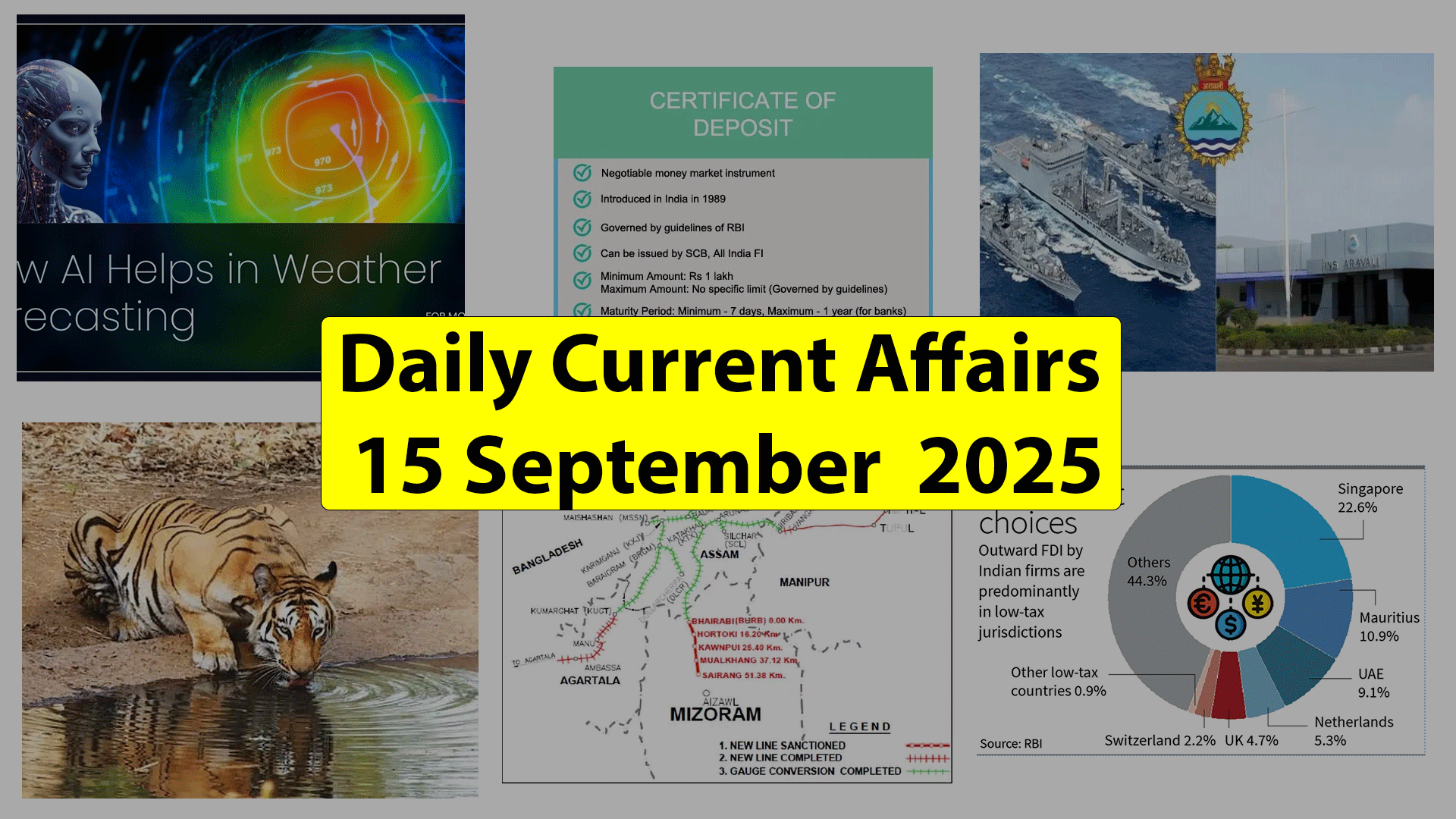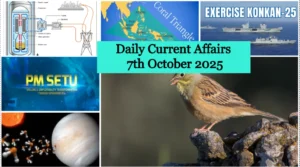Daily Current Affairs -15th September 2025
Daily Current Affairs -15th September 2025
India’s Outward FDI Trends
Nearly 60% of India’s outward FDI is now routed through tax havens like Singapore, Mauritius, and the UAE, reflecting both tax advantages and strategic global expansion needs.
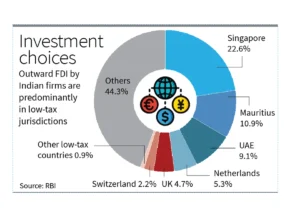
Introduction –
- India’s outward foreign direct investment (FDI) has grown significantly over the past two decades, reflecting the ambition of Indian companies to expand their global presence.
- While domestic reforms have supported inbound investment, outward investment trends reveal a distinct preference for low-tax
- According to Reserve Bank of India (RBI) data, nearly 60% of India’s outward FDI in 2023-24 was routed through tax havens such as Singapore, Mauritius, and the UAE.
- This pattern highlights not only tax efficiencies but also strategic advantages for Indian companies seeking global expansion.
India’s Outward Investment Trends –
- India’s outward FDI has witnessed structural changes in both volume and destination
- From traditional investments in manufacturing and energy, Indian firms have diversified into IT services, pharmaceuticals, consumer goods, and infrastructure globally. The main objectives driving this trend include:
- Access to new markets: Indian companies are establishing subsidiaries abroad to tap into consumer demand in Europe, the S., and Africa.
- Technology acquisition: Outward investments enable Indian firms to access advanced technologies, particularly in healthcare, automotive, and clean
- Strategic partnerships: Cross-border mergers, acquisitions, and joint ventures strengthen Indian firms’ positioning in global supply chains.
- Risk diversification: By expanding abroad, companies hedge against domestic regulatory and market volatility.
- The government has supported outward FDI by easing regulatory approvals, enhancing bilateral investment treaties, and facilitating credit support through institutions like EXIM
- However, the heavy reliance on tax havens underscores a complex mix of regulatory arbitrage, strategic structuring, and global investor preferences.
News Summary –
- Recent data shows that 56% of India’s outward FDI in 2023–24, amounting to about 1,946 crore out of a total of Rs. 3,488 crore, flowed into low-tax jurisdictions such as Singapore (22.6%), Mauritius (10.9%), and the UAE (9.1%).
- In the first quarter of 2024-25, this figure rose further, with 63% of outward FDI routed through these Experts clarify that this is not solely for tax avoidance but also for strategic reasons —
- Global investor comfort: International partners prefer investing in entities located in jurisdictions with stable tax laws and flexible fund transfer
- Strategic structuring: Using special-purpose vehicles in hubs like Singapore helps Indian companies attract investors and manage stake dilutions effectively.
- Joint ventures: Almost 60% of outward FDI in these low-tax hubs in July 2025 was in joint ventures, showing their role as neutral platforms for
- Experts also note that rising S. tariffs on Indian exports could push more firms to establish subsidiaries abroad to mitigate trade risks.
- Thus, while India continues efforts to curb profit shifting to tax havens, the outward FDI trend reflects a blend of tax advantages and global business strategy.
Conclusion –
- India’s outward FDI trajectory highlights a dual narrative: on one hand, concerns about tax revenue leakage and regulatory arbitrage; on the other, the strategic necessity for Indian firms to leverage tax-efficient jurisdictions to expand
- With nearly 60% of investments flowing through tax havens, it is evident that these destinations serve as both gateways for third-country expansion and buffers against global trade risks.
- Going forward, India’s challenge will be to balance regulatory oversight with the need to support its companies’ global ambitions.
Enhanced Powers of Foreigners’ Tribunals
The Union Home Ministry has notified Rules, Order, and Exemption Order under the Immigration and Foreigners Act, 2025.
This law regulates all matters on foreigners and immigration, replacing older legislations including the Passport (Entry into India) Act, 1920, the Registration of Foreigners Act, 1939, the Foreigners Act, 1946, and the Immigration (Carriers’ Liability) Act, 2000.
Rationale Behind the New Immigration and Foreigners Act –
- The government introduced the Immigration and Foreigners Act, 2025 to prevent overlap among multiple pre-Independence laws on passports, travel documents, visas, registration, and
- While most provisions existed in earlier notifications, new clauses and conditions have been added to address significant changes in travel, security, and immigration that have emerged since the old Acts were enacted.
Key Provisions of the Immigration and Foreigners Rules –
- The new Rules formally empower the Bureau of Immigration (BOI) to investigate immigration fraud, coordinate with states on identifying and deporting foreigners, and maintain an immigration database.
- They also mandate biometric recording of all foreigners, previously limited to select visa
- Educational institutions must now report details of all foreign students, including semester-wise attendance and conduct, to the Foreigners Regional Registration Office (FRRO).
- Additionally, premises such as resorts or clubs can be shut down if frequented by illegal migrants, alongside earlier categories of undesirable foreigners or those linked to
- The Rules also define “immigration officers” as Intelligence Bureau
Provisions of the Immigration and Foreigners Order, 2025 –
- The Immigration and Foreigners Order, 2025 grants Foreigners Tribunals (FTs), earlier unique to Assam, the powers of a first-class judicial magistrate, enabling them to send individuals without proof of citizenship to detention or holding
- FTs can now issue arrest warrants if contested individuals fail to appear, with membership capped at three, and ex-parte orders open for review within 30 days.
- Though applicable nationwide, FTs currently operate only in Assam, where 100 are functional after the NRC process excluded 19 lakh applicants.
- The Order also legalises the role of border forces like BSF and Assam Rifles in preventing illegal entry by recording biometric and demographic data before sending migrants back.
- Entry refusal now includes broader grounds such as anti-national activities, terrorism, espionage, human trafficking, cybercrime, narcotics trade, financial crimes like hawala, and crimes against humanity.
Immigration and Foreigners (Exemption) Order, 2025 –
- The Exemption Order spares Nepalese, Bhutanese, and Tibetans from the Immigration and Foreigners Act, 2025, while adding two new groups.
- Registered Sri Lankan Tamil nationals who sought shelter in India before January 9, 2015, are exempted from the passport/visa requirements under Section 3.
- Additionally, undocumented minorities from Afghanistan, Bangladesh, and Pakistan — including Hindus, Sikhs, Buddhists, Jains, Parsis, and Christians — who entered India without valid documents or whose documents expired before December 31, 2024, are exempted from penal provisions and deportation.
- However, only these minorities can apply for long-term visas (LTVs) leading to citizenship, while the exemption for Sri Lankan Tamils does not extend to LTVs.
Market Reforms
SEBI has announced major market reforms, including the SWAGAT-FI framework for foreign investors, relaxed IPO dilution norms, and stronger governance measures for exchanges.
Introduction –
- The Securities and Exchange Board of India (SEBI) has announced sweeping reforms aimed at enhancing foreign investment inflows, easing IPO norms for large companies, and strengthening governance within market infrastructure
- These measures come at a time of heightened global economic uncertainty, with foreign portfolio investors (FPIs) pulling out significant capital due to U.S. tariffs, rich valuations, and weak corporate earnings.
- The reforms are expected to reinforce India’s reputation as a competitive and investor-friendly market while balancing investor protection and regulatory compliance.
Foreign Investor Access through SWAGAT-FI –
- One of the most significant announcements is the introduction of the Single Window Automatic & Generalised Access for Trusted Foreign Investors (SWAGAT-FI)
- Scope: It covers FPIs and Foreign Venture Capital Investors (FVCIs) from categories such as sovereign wealth funds, central banks, insurance companies, pension funds, and regulated retail
• Features —
- A unified 10-year registration and KYC cycle (up from 3 years).
- Exemption from the 50% cap on aggregate contributions by NRIs, OCIs, and resident
- Simplified compliance and reduced paperwork through the India Market Access portal, launched alongside SWAGAT-FI.
- Impact — The move aims to restore investor confidence amid record foreign outflows of nearly Rs. 63,500 crore since July 2025.
Relaxed IPO Norms for Large Companies –
- SEBI has also eased the minimum public offer (MPO) and public shareholding requirementsfor large issuers:
- Companies with Rs. 1-5 lakh crore market cap must now offer 75-2.8% of their post-issue market cap, compared with 5% earlier.
- MPO size threshold raised to 6,250 crore for very large issuers.
- Public float timeline — Firms with less than 15% public shareholding at listing now get 10 years (up from 3–5 years) to meet the 25% minimum requirement.
• Anchor Investor rules —
- Anchor quota raised to 40% from one-third, including allocations for mutual funds, life insurers, and pension funds.
- Minimum allotment size set at 5 crore.
- Broader anchor investor participation permitted.
- These reforms are particularly beneficial for mega-IPOs, where immediate high dilution often deters promoters.
Strengthened Governance in Market Infrastructure Institutions –
- SEBI has introduced structural changes to improve the governance of stock exchanges and clearing corporations:
- Two executive directors will head separate verticals – critical operations (trading, clearing, settlement) and regulatory compliance (risk management, investor grievances).
- Defined roles for managing directors and key managerial personnel, enhancing accountability and succession planning
- This comes in the wake of past governance concerns in major exchanges, where lapses undermined market trust.
Mutual Fund and Retail Investor-Centric Reforms –
- To deepen financial inclusion, SEBI has announced measures to improve retail participation, especially from smaller towns and underrepresented groups —
- Exit load in mutual funds has been reduced to 3% from 5%.
- Distributor incentives revised to promote investments from beyond top-30 cities (B-30)and to encourage participation by women investors.
- Enhanced disclosure and compliance norms for related-party transactions (RPTs), with thresholds linked to company turnover.
Significance of the Reforms –
- For India’s markets: They provide flexibility for large companies tapping equity markets and simplify investment processes for trusted foreign players.
- For global competitiveness: SWAGAT-FI positions India as a stable long-term investment hub amid global capital volatility.
- For retail investors: The focus on smaller cities and women investors aligns with India’s push for inclusive financial growth.
Sarcoidosis
A peer-reviewed study published recently provides an in-depth analysis of sarcoidosis, highlighting its variable course and the factors that influence disease severity.
About Sarcoidosis –
- Sarcoidosis is a condition that causes your immune system to overreact and make lumps or nodules called granulomas.
• A granuloma is an area of inflammation caused by your immune system.
- It’s made up of a cluster of white blood cells that have been “walled off” from the rest of your body to try to protect you from something your immune system thought was
- Granulomas are surrounded by fibrous (dense) tissue, which makes them feel hard and
- Granulomas can be found almost anywhere in your body, but they’re most commonly found in your lungs or lymph nodes.
- They also can occur in the eyes, skin, heart, and other
• Cause —
- Experts don’t know the exact cause of sarcoidosis, but it’s likely a mix of genetic and environmental factors.
- Some people appear to have gene changes that make them more likely to develop
- The condition may then be triggered by bacteria, viruses, dust, or
- Their immune system overreacts to the trigger, causing inflammation that forms
• Symptoms —
- Depending on location and size, granulomas can cause mild to severe symptoms or no symptoms at all.
- Symptoms include cough, shortness of breath, tender sores on your shins, eye pain, and
- Many cases go away on their own or with treatment, but sometimes it becomes a chronic
• In some cases, they can turn into fibrosis, causing permanent lung scarring.
• Treatment —
- There is no cure for sarcoidosis, but most people do not need
- Sarcoidosis may go away on its
• Other people need treatment to lessen their body’s immune system response.
- Sometimes sarcoidosis can last for years and may cause organ
Certificate of Deposit (CD)
Issuance of certificates of deposit (CDs) by banks has fallen sharply in the last few months, pushing mutual funds to explore alternative money market instruments such as treasury bills and commercial papers to park funds.
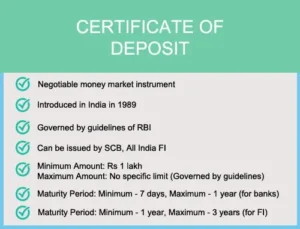
About Certificate of Deposit (CD) –
- It is a fixed-income financial tool that is governed by the Reserve Bank of India (RBI) and is
issued in a dematerialised form.
- It is a type of agreement made between the depositors and the banks, wherein the bank pays an interest on your investment.
- It is a short-term investment that comes with fixed investment amounts and maturity tenure ranging between 1-3 years.
• Features of CD —
- A CD in India can be issued for a minimum deposit of 1 lakh or in subsequent
multiples of it.
• Eligibility Criteria —
• CDs are issued by the Scheduled Commercial Banks (SCBs) and All-India Financial Institutions.
- The Cooperative Banks and the Regional Rural Banks (RRBs) are not eligible for issuing a CD.
- It is issued to individuals, corporations, companies, and funds, among
• CDs could also be issued to NRIs but on a non-repatriable basis only.
• Maturity Period —
- The maturity period of a CD can range between 7 days and 1 year when issued by commercial banks.
- However, for other financial institutions, the maturity period ranges from 1 year to 3
- CDs are offered at discount rates or floating rates, depending on the banks’
- Interest Rates: A CD offers a higher interest rate than savings accounts or some other fixed-term financial products.
- CDs in dematerialised form can be transferred through endorsement or delivery, similar to dematerialised securities. This feature enhances the liquidity and ease of transactions for CDs.
- Unlike some other financial instruments, there is no lock-in period for a This flexibility allows investors to access their funds or reinvest after the agreed-upon term without restrictions.
- Since CDs do not have any lock-in period, CDs cannot be used as collateral, and banks can’t buy back their own CDs before maturity.
• Banks have to maintain the statutory liquidity ratio and cash reserve ratio on the price of a CD.
- A CD is fully taxable under the Income Tax
• A CD cannot be publicly traded.
AI-based Weather Forecasting Program
The Ministry of Agriculture and Farmers’ Welfare (MoAFW) launched AI-based monsoon forecasts via SMS (m-Kisan) to nearly 3.8 crore farmers across 13 states this year.

About AI-Based Weather Forecasting Program –
- It was launched by the Ministry of Agriculture and Farmers’
- Under this initiative AI-based monsoon forecasts was sent using m-Kisan
- This is the first-of-its-kind targeted dissemination of AI weather forecasts to
- These AI-based forecasts distributed by the MoAFW correctly identified 20 days’ pause in monsoon progression.
- The government sent updated information to farmers every week until continuous rains arrived in their area.
• AI Models used —
- The forecasts used were a blend of two open-access models—Google’s Neural GCM and European Centre for Medium-Range Weather Forecasts’ (ECMWF) Artificial Intelligence Forecasting Systems (AIFS).
- Significance — It centres specifically on the needs of farmers by providing tailored weather forecasts in easy to understand language and helps them make informed farming decisions.
What is m-Kisan Portal?
- It is a platform which provides web-based mobile advisory to farmers with the technological backstopping from Research Institutes and Agricultural Universities supporting farmers.
- It enables all Central and State government organisations in agriculture and allied sectors to provide information/services/advisories to farmers by SMS in their language, preference of agricultural practices and location.
- Through this portal messages are tailored to the farmer’s language, location, and preferred practices, helping them stay updated on weather, crops, pest control, and government
Bairabi-Sairang Rail Line
The Prime Minister recently inaugurated Mizoram’s first-ever railway line, the Bairabi–Sairang broad-gauge project, marking a historic moment in the state’s connectivity journey.
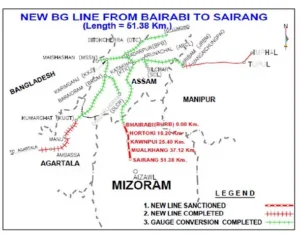
About Bairabi-Sairang Rail Line –
• It extends connectivity from Bairabi on the Assam–Mizoram border to Sairang, just 20 km from Aizawl (capital of Mizoram), directly linking the state capital with India’s railway network for the first time.
• With the new connection, Aizawl becomes the fourth northeastern state capital linked to the national railway network after Guwahati, Agartala, and Itanagar.
- The Bairabi–Sairang line stretches 38 km, running through some of the most challenging and hilly terrain in the
- The project includes 48 tunnels, 142 bridges (55 major and 87 minor), and multiple road overbridges and underbridges.
• Notably, Bridge No. 196 stands 104 meters tall- taller than Delhi’s Qutub Minar- making it the highest bridge in the state and the second-highest pier bridge in Indian Railways.
- The total length of tunnels in this project is 12,853
- The passenger trains can run at speeds of up to 100 kmph on the newly built rail
- The line was built at a cost of over Rs 8,070
Border Wing Home Guards
The Union Ministry of Home Affairs (MHA) is contemplating a plan to raise Border Wing Home Guards (BWHG) along the border with China, similar to the guards on the India-Pakistan border.
About Border Wing Home Guards –
- It acts as ancillaries to the Army and other border forces during
- Home Guards are raised under the Home Guards Act and Rules of the States/Union
- They are raised under the Home Guards Act,
- There are seven States authorised to have BWHGs: Meghalaya, Tripura, Assam, West Bengal, Punjab, Rajasthan, and Gujarat.
- Rajasthan is the only State which has BWHGs in the present
- They perform the responsibilities of a Constable and are usually enlisted for three to four
- 25% cost of training and financial support is borne by the Government of
- Who are recruited? They are recruited from amongst all classes of people and walks of life, who give their spare time to the organisation for betterment of the
• Role of Home Guards —
- They work in conjunction with the army in guarding the vital Installations, the vital points and the vulnerable areas during break out of hostilities on the International
- It works as an auxiliary Force to the Police in maintenance of internal security situations, help the community in any kind of emergency such as an air-raid, fire, cyclone, earthquake, epidemic etc.
- They help in maintenance of essential services, promote communal harmony and assist the administration in protecting weaker sections.
INS Aravali
Recently, the Indian Navy commissioned its latest Naval Base, INS Aravali, at Gurugram.

About INS Aravali –
- It is named after the Aravali mountain
- It is designed to strengthen the Navy’s information and communication infrastructure.
- It is located at Gurugram,
- Motto — It is guided by the motto ‘Maritime Security through Collaboration’.
- It is designed to support naval information and communication centres that are critical to India’s maritime security, command and control operations, and Maritime Domain Awareness (MDA).
- It embodies a spirit of cooperation with other naval units, MDA centres, and allied
- It marks a strategic step forward in the Navy’s efforts to enhance situational awareness and
inter-agency coordination across India’s maritime domain.
- The emblem reflects the base’s commitment to safeguarding India’s maritime interests through constant readiness and innovation.
- It also fulfill the India’s collaborative vision of MAHASAGAR, or Mutual and Holistic Advancement for Security and Growth Across Regions.
- Symbolism of the crest: It features a central mountain symbol, representing the steadfast strength of the Aravali range, and a rising sun, signifying eternal vigilance, resilience, and the dawn of advanced technological capabilities in communications and domain awareness.
- Strategic Role — It would strengthen India’s role as the Preferred Security Partner in the Indian Ocean Region.
Exercise Siyom Prahar
Recently, the Indian Army successfully conducted Exercise Siyom Prahar.
About Exercise Siyom Prahar –
- It is a major field training exercise conducted by the Indian
- It is aimed at validating the employment of drone technology in modern tactical
- It was held under realistic battlefield conditions and marked “a significant step in operational preparedness” by integrating unmanned aerial systems across tactical and operational
- The drones were employed for persistent surveillance, battlefield reconnaissance, target acquisition and precision strikes, underscoring their role in enhancing combat effectiveness.
- Focus — The central focus of the exercise was the development and validation of new Tactics, Techniques and Procedures for future battlefields.
- It included methods of fusing drone-derived intelligence with conventional firepower, refining joint targeting processes and ensuring rapid decision-making in dynamic combat environments.
• Significance —
- The exercise highlighted the importance of adaptability and synergy between traditional combat arms and emerging technological enablers, the official added.
- This exercise reflected the Indian Army’s proactive approach to adapting to modern warfare and its emphasis on future-readiness.
STAR Missile
STAR ends India’s dependence on expensive imported target systems for missile training.

About STAR Missile –
- The Supersonic TARget (STAR) missile is an indigenous, high-speed missile designed to
simulate realistic threats for training India’s armed forces.
• It was developed by the Defence Research and Development Organisation (DRDO).
- Unlike combat missiles, STAR doesn’t aim to destroy enemy targets—instead, it mimics the enemy, helping our forces practice interception in real-time.
- The STAR missile is engineered to simulate the behavior of modern supersonic anti-ship missiles and cruise missiles.
- To serve different combat needs, DRDO is developing STAR in two variants —
- Air-Launched STAR: Carried by fighters like the LCA Tejas, it simulates air-to-air and air- to-ground strikes, including Anti-Radiation and Anti-AWACS roles.
- Ground-Launched STAR: Truck-mounted and mobile, this version can be deployed from shorelines or remote zones without expensive infrastructure, making it highly versatile for Navy and Army drills.
• Features —
- At the heart of STAR is a two-stage propulsion system:
• Solid booster rocket for quick lift-off
- Liquid Fuel Ramjet (LFRJ) for sustained supersonic flight
• Max Speed: Mach 1.8 – 2.5.
- It operates across a wide altitude range from 100 meters to 10 kilometers, with an
operational range of 55 to 175 kilometers.
- With flight times spanning 50 to 200 seconds, it can simulate various attack scenarios, flying as low as 12 feet above water to mimic modern sea-skimming missiles or plunging from over 30,000 feet to replicate high-altitude
- High Manoeuvrability: Simulates zig-zag, evasive enemy
- Tracking by Defence Systems: Test radar, missile interception, and tracking
- Safe Recovery or Detonation: Depending on mission
Amrit Sarovar Mission
The Government recently informed that over 68 thousand ponds have been created under the Amrit Sarovar Mission.
About Amrit Sarovar Mission –
- It was launched in April 2022 to construct or rejuvenate 75 Amrit Sarovars (ponds) in each district of the country as a part of the celebration of Azadi ka Amrit Mahotsav.
- It helps to overcome the water crisis in rural areas of the
• Salient Features of the Mission —
• Every Amrit Sarovar will have a pondage area of at least 1 acre with a water holding capacity of about 10,000 cubic metre.
- Every Amrit Sarovar will be surrounded by trees like Neem, Peepal, and Banyan,
- Every Amrit Sarovar will be a source of generation of livelihoods by using the water for different purposes like irrigation, fisheries, duckery, cultivation of water chestnut, water tourism, and other activities.
- The Amrit Sarovar will also act as a social gathering point in that
- The site of Amrit Sarovars will be approved by special Gram Sabha, which will also name Panchayat Partinidhi, who will supervise the development of Amrit Sarovar on its behalf.
- It focuses on water conservation, people’s participation, and proper utilisation of soil excavated from the water bodies to boost infrastructure projects.
- It is based on the “Whole of Government” approach with the participation from the Ministry of Rural Development, Ministry of Jal Shakti, Ministry of Culture, Ministry of Panchayati Raj, Ministry of Environment, Forest & Climate Change, and technical
- There is no separate financial allocation for Mission Amrit
- Mission Amrit Sarovar works are being taken up by the states and districts with convergence from various ongoing schemes such as Mahatma Gandhi NREGS, 15th Finance Commission Grants, Pradhan Mantri Krishi Sichayi Yojna sub-schemes such as the Watershed Development Component, Har Khet ko Pani, besides States’ own schemes.
- Bhaskar Acharya National Institute for Space Application and Geo-informatics (BISAG- N) has been engaged as a technical partner for the Mission.
- Amrit Sarovar Portal and Mobile App developed by BISAG-N is used for tracking the progress/ performance of Mission Amrit Sarovar in districts.
National Botanical Research Institute
The National Botanical Research Institute (NBRI) recently achieved a breakthrough by cultivating the exotic flower, Eustoma, native to Mexico and America, in Odisha after successfully growing it on its campus in Lucknow.
About National Botanical Research Institute (NBRI) –
- It is amongst one of the constituent research institutes of the Council of Scientific and Industrial Research (CSIR).
- It is located in the city of Lucknow, Uttar
- It is a multi-disciplinary plant research centre of international repute, undertaking basic and applied R&D programmes in several strategically important areas of plant sciences.
- Originally set up as the National Botanic Gardens (NBG) by the State Government of Uttar Pradesh (U.P.), it was taken over by the CSIR in 1953.
- Though initially engaged in research work in the classical botanical disciplines, the NBG went on laying an increasing emphasis, in keeping with the national needs and priorities in the field of plant sciences, on its applied and developmental research activities.
- NBG was renamed as the NBRI, e., The National Botanical Research Institute in 1978.
• Objectives —
- Basic and applied research on plant diversity and prospection, plant-environment interaction and biotechnological approaches for plant improvement.
- Development of technologies for new plant and microbial sources of commercial
- Building up germplasm repository of plants of indigenous and exotic origin, including rare, endangered and threatened species
• Providing expertise and assistance for identification, supply and exchange of plants
and propagules, garden layout and landscaping.
- Dissemination of scientific knowledge and technologies on plants and microbial resources through publications, training, capacity building and extension activities
- The NBRI R&D department has seven divisions under which they conduct various Those seven divisions are
- Plant Diversity, Systematics and
- Pharmacognosy, Phytochemistry and Product
- Plant Ecology and Environment
- Molecular Biology and
- Plant Genetic Resources and
- Botanical Garden, Plant Conservation and Agro-
- S & T
- CSIR-NBRI is equipped with state-of-the-art laboratories to support R&D.
- CSIR-NBRI has a well-designed Botanic Garden spread over 25 hectares with documented collections of about 5,000 indigenous and exotic plant species and varieties.
• It has an herbarium with 253,103 reference collections of flowering and non-flowering plants of India and two field research stations at Banthra.
- The institute is known for its outstanding contributions to enriching the knowledge base on India’s plant diversity, particularly in developing globally competent biotech and microbial technologies, herbal products, and plant databases.
• NBRI is recognized as a leading institute and referral center by different Ministries/ Departments of the Government of India and the United Nations in matters related to the
Convention on Biological Diversity (CBD), Traditional Knowledge, and Intellectual Property Rights.
- The Institute has been recognized by Government of India as one of the National Repositories for Indian flora under the National Biodiversity Authority and as per the provisions of the Biological Diversity Act, 2002.
Murikooti Pacha
Researchers at the Jawaharlal Nehru Tropical Botanic Garden & Research Institute (JNTBGRI), Palode, have tapped into the wound-healing properties of the red ivy plant, known locally as “murikooti pacha”.
About Murikooti Pacha –
- Murikooti Pacha or Red Ivy plant (Strobilanthes alternate), belongs to the Acanthaceae
- Other names — Red Flame Ivy, Purple Waffle
• Habitat & Distribution of Murikooti Pacha —
- Itis native to tropical Asia, particularly
- It is widely cultivated in India, Indonesia, China, and
- It thrives in moist, shaded environments and is commonly found in gardens and as ground
• Applications of Murikooti Pacha —
- Traditional practitioners use its leaf paste applied to fresh wounds, cuts, ulcers, and inflamed areas to promote healing and reduce inflammation.
- Also its leaf extracts are used traditionally to treat anaemia, gallstones, prolonged menstruation, haemorrhoids and diabetes.
Key features of Wound-healing Pad –
- The key ingredient in the multi-layered wound pad developed by the scientists is the acteoside molecule derived from the red ivy plant, which has high efficacy even at lower concentrations of 2%.
- It has been designed with a specially engineered electro-spun nanofiber layer, made from biodegradable and non-toxic polymers and is incredibly thin.
- Acteoside is a natural compound found in many plants and its pharmacological activities and therapeutic potential is well-known. This is the first time acteoside has been linked to the red ivy
- Along with acteoside, it also incorporates the antibiotic neomycin sulfate, blended with FDA- approved polymers.
Cicadas
Scientists with the Botanical Survey of India (MoEF&CC), Southern Regional Centre, Coimbatore, said that resurgence of cicadas in Silent Valley is a telling sign of ecological upheaval.
About Cicadas –
- Cicadas are hemipteran insects known for their loud, complex and species-specific acoustic signals or songs.
- A cicada has the best chance of survival if it can emerge from the ground when its predators are lying dormant.
- Cicadas are insects that spend most of their lives underground and emerge from the soil mainly to mate.
- Habitat — Most cicadas are canopy dwellers and are found in natural forests with large
- Types — Scientists divide the over 3,000 cicada species into two groups: annual and
- Annualcicadas: They emerge from the ground at different times each
- They’re usually dark with greenish
- These insects avoid predators by camouflaging themselves in the trees and flying from hungry birds and moles
- Periodical cicadas: Only seven species of cicadas are in the periodical
- These bugs all emerge from the ground at the same time(Summer).
- These groups appear after a dormant period of either 13 or 17
- Ecological Significance — They prune mature trees, aerate the soil, and once they die, their bodies serve as an important source of nitrogen for growing trees.
Erra Matti Dibbalu
Recently, Andhra Pradesh’s Erra Matti Dibbalu (Red Sand Dunes) have been included in the UNESCO Tentative List of World Heritage Sites.
About Erra Matti Dibbalu –
- Erra Matti Dibbalu, also known as the Red Sand Dunes is located along the coast near Visakhapatnam in Andhra Pradesh.
- It was first documented by British geologist William King in 1886, these formations are regarded as rare coastal geomorphological features.
• Key Features of Erra Matti Dibbalu —
- It is composed of sand, silt, and clay, with their distinct reddish hue resulting from natural oxidation over thousands of years.
- The uniqueness of this site is that the red sediments are a part of the continuation of the evolution of the earth and represent the late quaternary geologic age.
- They exhibit badland topography with different geomorphic landforms and features, including gullies, sand dunes, buried channels, beach ridges, paired terraces, the valley in the valley, wave-cut terrace, knick point and
- It is a lively scientific evolution site, which depicts the real-time effects of climate
- The site also has archaeological significance, as studies of artefacts indicate an Upper Palaeolithic horizon and on cross dating assigned to Late Pleistocene epoch, which is 20,000 BC.
- The site contains dendritic drainage patterns and sediment layers that record fluctuations in sea level and climatic changes over the late Quaternary period.
- Other similar sites — Only two other similar sites exist in the world, one in Sri Lanka and another in Tamil Nadu (Teri Sands).
- The Geological Survey of India (GSI) declared Erra Matti Dibbalu a National Geo-heritage Monument in 2016.
- Issues — Experts note that the site faces threats from tourism and filming
Gandhi Sagar Wildlife Sanctuary
Madhya Pradesh wildlife officials have initiated plans to introduce a female cheetah to the Gandhi Sagar wildlife sanctuary.
About Gandhi Sagar Wildlife Sanctuary –
- Location — It is situated in northwestern Madhya Pradesh, along the Madhya Pradesh- Rajasthan border and lies within the Khathiar-Gir dry deciduous forests ecoregion.
• Key features —
- It was declared a sanctuary in 1974, covering an area of 368 km.
- Rivers:The Chambal River flows through the sanctuary, dividing it into two
- It is a designated Important Bird and Biodiversity Area (IBA).
- The sanctuary houses sites of historical and archaeological significance, such as Chaurasigarh, Chaturbhujnath Temple, Bhadkaji rock paintings, Hinglajgarh Fort,and Taxakeshwar Temple.
- Topography and Vegetation — The sanctuary includes hills, plateaus, and the catchment area of the Gandhi Sagar Dam.
- Vegetation — Northern tropical dry deciduous forest, Northern tropical dry mixed deciduous forest, Dry deciduous scrub.
- Flora — It mainly consists of Khair, Salai, Kardhai, Dhawda, Tendu, and Palash
- Fauna — Chinkara, Nilgai, and Spotted Deer, Indian Leopard, Striped Hyena, and Jackal
Sahyadri Tiger Reserve
Recently, the Union Environment Ministry has approved the capture of eight tigers from the Tadoba-Andhari and Pench reserves for their translocation to the Sahyadri Tiger Reserve in western Maharashtra.

About Sahyadri Tiger Reserve –
- It is located in the Sahyadri Ranges of the Western Ghats in
- It is the first Tiger Reserve of Western Maharashtra and the fourth Tiger Reserve of the State spreading over two Protected Areas of Koyana Sanctuary (KWLS) and Chandoli National Park (CNP).
- The central portion of Sahyadri Tiger Reserve is occupied by the “Shivsagar” reservoir of the
Koyana River and the “Vasant Sagar” reservoir of the Warana River.
- Terrain — The total area of STR is undulating, with steep escarpments along the western
- The most distinct feature is the presence of numerous barren rocky and lateritic plateaus, locally called “Sadas”, with less perennial vegetation and overhanging cliffs on the edges, along with numerous fallen boulders with dense thorny bushes.
- Vegetation — The forest cover here is that of moist evergreen, semi-evergreen, moist, and dry deciduous vegetation.
- It is the only place where climax and near-climax vegetation are plentiful and prospects of adverse anthropogenic influence in the future are
• Flora —
- There are many medicinal and fruit-bearing trees along with the commercial hard wood trees in the reserve.
- The most common floral species found here are Anjani (Memecylon umbellatum), Jambhul (Syzygium cumini), and Pisa (Actinodaphaone Angustifolia).
• Fauna —
- The main carnivores are the tiger, leopard, and some lesser cats along with the wolf, jackal, and wild dog.
- The large herbivores are several deer species like Barking Deer, Sambar
Tipeshwar Wildlife Sanctuary
Recently, a Forest Department team conducting a routine patrol at Tipeshwar Wildlife Sanctuary (TWS) discovered a poached pangolin.
About Tipeshwar Wildlife Sanctuary –
- Location — It is located in the district of Yavatmal, Maharashtra.
- Spanning across 148.63 sq.km., the sanctuary derives its name from the nearby ‘Goddess Tipai’ shrine located in the Tipeshwar village.
- Mainly, the sanctuary sprawls amongst the Patanbori and Parwa Ranges of the Pandarkawad Forest Division.
- Four rivers — Purna, Krishna, Bhima, and Tapti—flow gracefully through the sanctuary, earning it the poetic title “Green Oasis of Eastern Maharashtra.”
- The land here is rich with basaltic soil, a remnant of ancient volcanic
- The sanctuary is home to several villages whose inhabitants rely on the forest for their daily
• Vegetation —
- The place is quite hilly and undulating and thus has different types of vegetation cover that varies with the altitude.
- The major forest type here is the ‘Southern Tropical Dry Deciduous Forests’.
• Flora —
- The forests of Tipeshwar are dominated by teak, which forms about 60% of the canopy,
alongside other tree species like Ain, Bija, and Dhawda.
- The undergrowth features a variety of grasses, bamboo groves, and medicinal
- Fauna — The place shelters a wide array of animals that include Hyena, Chital, Black buck, Sambar, Jackal, Wild boar, Peacock, Monkey, Blue bull, Wild cat, Bear and many more.
Congo River
Over 107 people have died following a whaleboat fire on the Congo River recently.
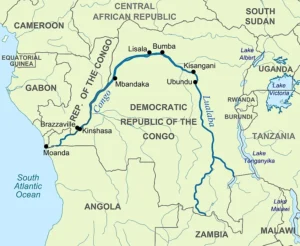
About Congo River –
- The Congo River, or Zaire River, is a river in west-central
- With a length of 2,900 miles (4,700 km), it is the continent’s second longest river, after the
Nile.
- It is also the world’s second-largest river by discharge volume after the
- It is also the world’s deepest river, with a maximum depth of 720 feet (220m), too deep for light to penetrate.
- It is the only major river that crosses the Equator
• Course —
- Origin: It rises in the highlands of northeastern Zambia between Lakes Tanganyika and Nyasa (Malawi) as the Chambeshi River at an elevation of 5,760 feet (1,760 metres) above sea level.
- Its course then takes the form of a giant counterclockwise arc, flowing to the northwest, west, and southwest before draining into the Atlantic Ocean at Banana (Banane) in the Democratic Republic of the Congo.
- It also empties water and sediment into one of the largest carbon sinks in the world, the Congo Plume in the Atlantic.
- The riverbed continues offshore with an 800 km-long submarine canyon that reaches a depth of 1,220 m.
- The Congo River system runs through the Republic of the Congo, the Democratic Republic of the Congo, the Central African Republic, western Zambia, northern Angola, and parts of Cameroon and Tanzania.
- Its drainage basin covers an area of 1,335,000 square miles (3,457,000 square km). It’s the
world’s second-largest river basin, after the Amazon River Basin.
- The basin is bordered by the Sahara Desert to the north, the Atlantic Ocean to the south and west, and the East African lakes region to the east.
- Because the river’s many large tributaries (including the Lomami, Kasai, Lulonga, Ubangi, Aruwimi, Itimbiri, and Mongala rivers) drain areas with rainy seasons that alternate on either side of the equator, the Congo has a fairly constant flow of water throughout the
- The mix of equatorial climate and massive water source provided by the river provides the perfect ingredients for the second-largest tropical rainforest in the world, the Congo Basin
- The Congo is easily navigable for most of its length, and much of the trade of Central Africa passes along it.
Scarlet Dragonfly
In a recent discovery, a rare scarlet dragonfly has been spotted in the valleys of Munnar, somewhere in Kerala’s Western Ghats.
About Scarlet Dragonfly –
- It is a species of dragonfly in the family
- Scientific Name — Crocothemis erythraea
- Its common names include broad scarlet, common scarlet-darter, and scarlet
• Distribution —
- It is a common species in southern Europe and throughout
- It also occurs across western Asia as far as southern
- Sometimes, these dragonflies travel far from their usual
• Habitat:
- Scarlet dragonflies like to live near
- They can be found near many types of water, like rivers, streams, and
- They prefer sunny spots, not places that are too
• Features —
- It can reach a length of 33–44 millimetres (1.3–1.7 in).
- These dragonflies have a flattened and rather broad
- The adult male scarlet dragonfly has a bright scarlet red, widened abdomen, with small amber patches at the bases of the hindwings.
• Also the veins on the leading edges of the wings are red.
- Females and immatures are yellow-brown and have a conspicuous pale stripe along the top of the thorax.
• Conservation Status —
- IUCN Red List: Least
Daily Current Affairs -15th September 2025 MCQs
1. Which of the following statement(s) is/are incorrect?
- Foreign Direct Investment is aimed to exert control over the management of the companies while the degree of such control in Foreign Portfolio Investment is less.
- Foreign Direct Investment is more difficult to sell off while the Foreign Portfolio Investment can be much more volatile.
- Foreign Direct Investment creates more productive assets directly but Foreign Portfolio Investment does not create productive assets directly.
Select the correct codes from below –
- 1 and 2 only
- 2 and 3 only
- 1 and 3 only
- None of the above
Answer – D
Explanation – All statements are correct. With FDI, investors are able to exert control over their investments and are typically actively involved in the management of the companies they invest in. Conversely, in FPI the degree of control is less as the investors obtain only ownership right. Therefore, they do not get a say in how their investments pan out because they’re not actively involved in the management or operations of the companies that they’re invested in. One of the most important distinctions between portfolio and direct investment to have emerged in the era of globalisation is that portfolio investment can be much more volatile. Changes in the investment environment in a country can lead to swift changes in portfolio investment. In contrast, FDI is more difficult to pull out or sell off as it implies a controlling stake in a business, and often connotes ownership of physical assets such as equipment, buildings and real estate. FDI investors invest in financial and non-financial assets like resources, technical know-how along with securities. This is contrary to FPI, where investors invest only in financial assets. For an economy as a whole, FDI creates productive assets by investing in factories, machinery & skill and superior technology. In that sense, FDI brings in long-term capital for an economy. FPI doesn’t aid productive asset creation directly. It is just a financial investment. The FPI investment pours funds generally into capital or bond markets for a short period of time, usually enough to make profits. Its destination period is small and its funds are generally considered short term capital.
2. With reference to the key provisions of the Immigration and Foreigners Act, 2025, consider the following statements –
- All foreign nationals, including Overseas Citizen of India (OCI) cardholders, are required to register with a Foreigners’ Regional Registration Officer (FRRO) upon entry.
- An Immigration Officer at a designated land border checkpoint has the authority to deny exit to an individual on grounds of national security.
- A private hospital is legally obligated to electronically report the birth of a child to foreign nationals within a specified time frame.
Which of the statements given above is/are correct?
- 1 and 2 only
- 2 and 3 only
- 3 only
- All of the above
Answer – B
Explanation – The Immigration and Foreigners Act, 2025, along with its accompanying Rules and Orders, introduces clear, centralised rules for regulating foreign nationals in India. Valid Documents and Entry Points — All entrants must carry a valid passport or travel document and, in the case of foreigners, a valid visa, unless exempted by the Act or special government orders. Entry and exit are permitted only through designated immigration posts, covering major airports, seaports, land border posts, and rail checkpoints. Role and Powers of Immigration Officers — Immigration Officers posted at these entry points hold final authority to validate or deny entry or exit. They can refuse admission on national security grounds. Registration and Local Control Mechanism — Foreigners must register with designated authorities, such as the SP/DCP or Foreigners’ Regional Registration Officers (FRROs), who oversee regulation at district and regional levels. Reporting Obligations of Accommodation Providers — Hotels, hostels, paying guest facilities, and religious institutions must digitally record and report details of foreign guests — including OCI card holders — within 24 hours of arrival and departure. Educational and Medical Institutions’ Duties — Universities must report admissions of foreign students, while hospitals must notify authorities of foreign patients, births, and deaths within seven days via electronic submission. Authority Over Premises Frequented by Foreigners — Civil authorities may restrict or shut down resorts, clubs, or similar venues if linked to criminal or unlawful activities, or if foreigners frequenting them are deemed undesirable. Relocation of such operations requires prior approval. Permits for Protected Areas — Access to protected, restricted, or prohibited areas now requires a special online permit. Applications must be filed on designated portals or apps, with standardised procedures in place.
3. With reference to the Doctrine of Contributory Negligence in India, consider the following statements –
- It is a statutory defence codified under a specific law of torts in
- The burden of proving that the plaintiff failed to exercise reasonable care lies with the
- The principle of ‘Volenti non-fit injuria’ forms the foundational basis for this
- The defence is not available if the defendant had a legal duty to exercise full care and
Which of the statements given above are correct?
- 1 and 2 only
- 2, 3 and 4 only
- 1, 3 and 4 only
- All of the above
Answer – B
Explanation – It operates on the principle that individuals have a duty to exercise reasonable care for their own safety and well-being. When someone fails to meet this duty and their actions or omissions contribute to their own injury or damages, they may be considered partially at fault for the harm suffered. Contributory negligence occurs when the plaintiff, through their own lack of care, contributes to the damage resulting from the defendant’s negligence or wrongful conduct. The concept of Contributory negligence is based on the principles of “Volenti non-fit injuria”. The maxim means that the injury has suffered voluntarily and the defendant is not fully liable. It serves as a defence wherein the defendant must demonstrate that the plaintiff’s failure to exercise
reasonable care for their safety played a role in the harm For instance, if A, while travelling on the wrong side of the road, is struck by a vehicle driven recklessly by B coming from the opposite direction, A may be met with the defence of contributory negligence. The application of contributory negligence principles allows courts to assess the relative fault of each party and determine the appropriate allocation of liability and damages in such cases. But if both the plaintiff and the defendant take due care and all the measures to avoid the accident or the injury, then the plaintiff cannot sue the defendant for that. The Burden of Proof: The burden of proof is on the defendant to prove that the plaintiff is equally liable for the act and the plaintiff was not careful, due to which he suffered injuries. The defence of contributory negligence is not available when it is proved that the defendant has the duty to take full care and he is legally bound to take full care and diligence. So, if any injury is caused to the plaintiff, then the defendant will be held liable. For example- A and B were travelling in a bus, and A, in order to show something to B, pointed his hand outside the window, and the window suddenly got open, and A was injured. Although it was A’s duty to not take out his hands from the window, the staff and the crew were liable, as it was their duty to check all the windows and the doors. While India does not have a specific statute codifying contributory negligence, courts often consider principles of fairness and equity in determining liability and apportioning damages. In India, the concept of comparative negligence is applied, where damages are allocated based on the comparative fault of each party involved and judges exercise discretion based on the facts and circumstances of each case.
4. Consider the following statements regarding Certificates of Deposit (CDs) in India –
- They can be issued by Scheduled Commercial Banks as well as Regional Rural
- Their minimum maturity period, when issued by a bank, is 7
- They are issued exclusively in a dematerialised
- They offer higher interest rates compared to regular savings bank
Which of the statements given above are correct?
- 1 and 2 only
- 2 and 4 only
- 2, 3 and 4 only
- All of the above
Answer – B
Explanation – It is a fixed-income financial tool that is governed by the Reserve Bank of India (RBI) and is issued in a dematerialised form. It is a type of agreement made between the depositors and the banks, wherein the bank pays an interest on your investment. It is a short-term investment that comes with fixed investment amounts and maturity tenure ranging between 1-3 years. Features of CD — A CD in India can be issued for a minimum deposit of Rs. 1 lakh or in subsequent multiples of it. Eligibility Criteria — CDs are issued by the Scheduled Commercial Banks (SCBs) and All-India Financial Institutions. The Cooperative Banks and the Regional Rural Banks (RRBs) are not eligible for issuing a CD. It is issued to individuals, corporations, companies, and funds, among others. CDs could also be issued to NRIs but on a non-repatriable basis only. Maturity Period — The maturity period of a CD can range between 7 days and 1 year when issued by commercial banks. However, for other financial institutions, the maturity period ranges from 1 year to 3 years. CDs are offered at discount rates or floating rates, depending on the banks’ requirements. Interest Rates: A CD offers a higher interest rate than savings accounts or some other fixed-term financial products. CDs in dematerialised form can be transferred through endorsement or delivery, similar to dematerialised securities. This feature enhances the liquidity and ease of transactions for CDs. Unlike some other financial instruments, there is no lock-in period for a CD. This flexibility allows investors to access their funds or reinvest after the agreed- upon term without restrictions. Since CDs do not have any lock-in period, CDs cannot be used as collateral, and banks can’t buy back their own CDs before maturity. Banks have to maintain the statutory liquidity ratio and cash reserve ratio on the price of a CD. A CD is fully taxable under the Income Tax Act. A CD cannot be publicly traded.
5. Consider the following statements regarding INS Aravali –
- It is a naval establishment designed to enhance India’s Maritime Domain Awareness (MDA).
- Its strategic location in a coastal state provides a direct operational advantage for maritime command and control.
- The motto and emblem of the base emphasise collaboration, constant readiness, and technological innovation.
Which of the statements given above is/are correct?
- 1 only
- 1 and 3 only
- 2 and 3 only
- All of the above
Answer – B
Explanation – It is named after the Aravali mountain range. It is designed to strengthen the Navy’s information and communication infrastructure. It is located at Gurugram, Haryana. Motto — It is guided by the motto ‘Maritime Security through Collaboration’. It is designed to support naval information and communication centres that are critical to India’s maritime security, command and control operations, and Maritime Domain Awareness (MDA). It embodies a spirit of cooperation with other naval units, MDA centres, and allied stakeholders. It marks a strategic step forward in the Navy’s efforts to enhance situational awareness and inter-agency coordination across India’s maritime domain. The emblem reflects the base’s commitment to safeguarding India’s maritime interests through constant readiness and innovation. It also fulfill the India’s collaborative vision of MAHASAGAR, or Mutual and Holistic Advancement for Security and Growth Across Regions. Symbolism of the crest: It features a central mountain symbol, representing the steadfast strength of the Aravali range, and a rising sun, signifying eternal vigilance, resilience, and the dawn of advanced technological capabilities in communications and domain awareness. Strategic Role — It would strengthen India’s role as the Preferred Security Partner in the Indian Ocean Region.
Also read Daily Current Affairs – 16 September 2025 | Top News

